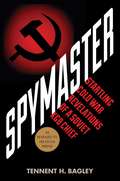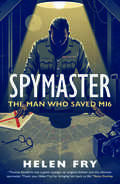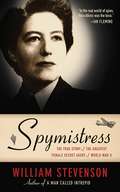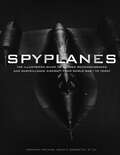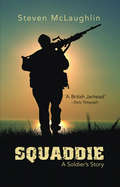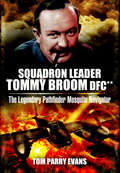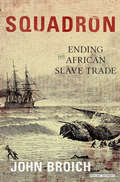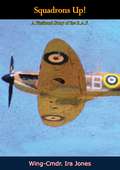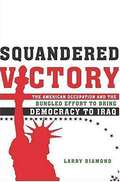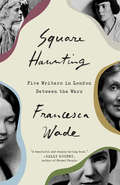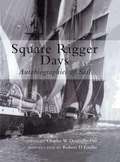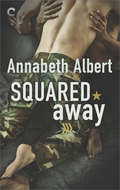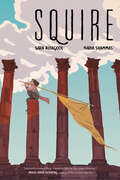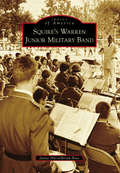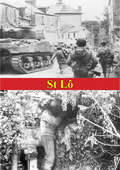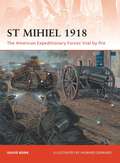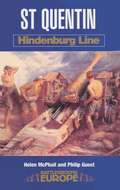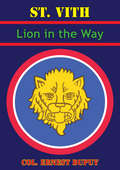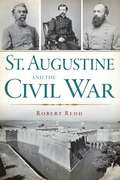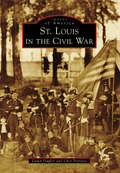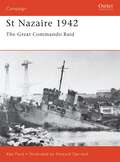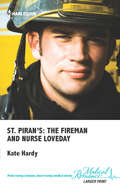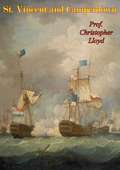- Table View
- List View
Spymaster: Startling Cold War Revelations of a Soviet KGB Chief
by Tennent H. BagleyFrom the dark days of World War II through the Cold War, Sergey A. Kondrashev was a major player in Russia's notorious KGB espionage apparatus. Rising through its ranks through hard work and keen understanding of how the spy and political games are played, he "handled" American and British defectors, recruited Western operatives as double agents, served as a ranking officer at the East Berlin and Vienna KGB bureaus, and tackled special assignments from the Kremlin.During a 1994 television program about former spymasters, Kondrashev met and began a close friendship with a former foe, ex-CIA officer Tennent H. "Pete" Bagley, whom the Russian asked to help write his memoirs.Because Bagley knew so about much of Kondrashev's career (they had been on opposite sides in several operations), his penetrating questions and insights reveal slices of never-revealed espionage history that rival anything found in the pages of Ian Fleming, Len Deighton, or John le Carré: chilling tales of surviving Stalin's purges while superiors and colleagues did not, of plotting to reveal the Berlin Tunnel, of quelling the Hungarian Revolution and "Prague Spring" independence movements, and of assisting in arranging the final disposition of the corpses of Adolf Hitler and Eva Braun. Kondrashev also details equally fascinating KGB propaganda and disinformation efforts that shaped Western attitudes throughout the Cold War.Because publication of these memoirs was banned by Putin's regime, Bagley promised Kondrashev to have them published in the West. They are now available to all who are fascinated by vivid tales of international intrigue.
Spymaster: The Man Who Saved MI6
by Helen FryThe dramatic story of a man who stood at the center of British intelligence operations, the ultimate spymaster of World War Two: Thomas Kendrick Thomas Kendrick (1881–1972) was central to the British Secret Service from its beginnings through to the Second World War. Under the guise of "British Passport Officer," he ran spy networks across Europe, facilitated the escape of Austrian Jews, and later went on to set up the "M Room," a listening operation which elicited information of the same significance and scope as Bletchley Park. Yet the work of Kendrick, and its full significance, remains largely unknown. Helen Fry draws on extensive original research to tell the story of this remarkable British intelligence officer. Kendrick&’s life sheds light on the development of MI6 itself—he was one of the few men to serve Britain across three wars, two of which while working for the British Secret Service. Fry explores the private and public sides of Kendrick, revealing him to be the epitome of the "English gent"—easily able to charm those around him and scrupulously secretive.
Spymistress: The True Story of the Greatest Female Secret Agent of World War II
by William StevensonShe was beautiful. She was ruthless. She had a steel trap for a mind and a will of iron. Born Vera Maria Rosenberg in Bucharest, she became Vera Atkins, legendary spy and holder of the Legion of Honor. Recruited by William Stevenson-the spymaster who would later come to be known as "Intrepid"-when she was only twenty-three, Vera spent much of the 1930s running countless perilous espionage missions. When war was declared in 1939, her fierce intelligence, blunt manner, personal courage, and knowledge of several languages quickly propelled her to the leadership echelon of the highly secretive Special Operations Executive (SOE), a covert intelligence agency formed by, and reporting to, Winston Churchill. She recruited and trained several hundred agents, including dozens of women, whose objectives were to penetrate deep behind enemy lines.The stirring exploits and the exemplary courage of the SOE agents and the French Resistance fighters-who in the words of General Dwight D. Eisenhower together "shortened the war by many months"-are justly celebrated. But the central role of Vera Atkins has until now been cloaked in silence. William Stevenson was the only person she trusted to record her life; he kept his promise that he would not publish her story until after her death. Here is the extraordinary account of the woman whose intelligence, beauty, and unflagging dedication proved key in turning the tide of World War II.
Spyplanes: The Illustrated Guide to Manned Reconnaissance and Surveillance Aircraft from World War I to Today
by Norman Polmar John F. BessetteA comprehensive history with descriptions of the world's most significant aircraft employed as "eyes in the sky."For as long as there has been sustained heavier-than-air human flight, airplanes have been used to gather information about our adversaries. Less than a decade after the Wright Brothers flew at Kitty Hawk, Italian pilots were keeping tabs on Turkish foes in Libya. Today, aircraft with specialized designs and sensory equipment still cruise the skies, spying out secrets in the never-ending quest for an upper hand.Spyplanes tackles the sprawling legacy of manned aerial reconnaissance, from hot air balloons to cloth-and-wood biplanes puttering over the Western Front, and on through every major world conflict, culminating with spyplanes cruising at supersonic speeds 85,000 feet above the Earth's surface. Authors Norman Polmar and John Bessette offer a concise yet comprehensive overview history of aerial recon, exploring considerations such as spyplanes in military doctrine, events like the Cuban Missile Crisis and the downing of Francis Gary Powers' U-2, the 1992 Open Skies Treaty, and the USAF's Big Safari program.Polmar and Bessette, along with a roster of respected aviation journalists, also profile 70 renowned fixed-wing spyplanes from World I right up to the still-conceptual hypersonic SR-72. The authors examine the design, development, and service history of each aircraft, and offer images and specification boxes that detail vital stats for each. Included are purpose-built spyplanes, as well as legendary fighters and bombers that have been retrofitted for the purpose. In addition, the authors feature preliminary chapters discussing the history of aerial surveillance and a host of sidebars that explore considerations such as spyplanes in military doctrine, events like the Cuban missile crisis and the downing of Francis Gary Powers' U-2, the 1992 Open Skies Treaty, and the USAF's current Big Safari program.From prop-driven to jet-powered aircraft, this is the ultimate history and reference to those "eyes in the skies" that have added mind-bending technologies, not to mention an element of intrigue, to military aviation for more than a century.
Spätverfolgung von NS-Unrecht
by Moritz Vormbaum75 Jahre nach dem Nürnberger Hauptkriegsverbrecherprozess ist die Strafverfolgung der nationalsozialistischen Systemverbrechen faktisch abgeschlossen. Der Band nimmt den letzten Akt der Strafverfolgung von NS-Unrecht in Deutschland in den Blick. Er knüpft an die in Wissenschaft, Praxis und allgemeiner Öffentlichkeit geführten Debatten über die Spätverfolgung an, zu einem Zeitpunkt, an dem die Erinnerung an die Verfahren noch frisch ist. Disziplinenübergreifend bietet der Band Analysen verschiedener Aspekte der Spätverfolgung und verknüpft das Thema mit dem internationalen "transitional justice"-Diskurs.Die Kapitel 1 Einführung, 11 Spätverfolgung von NS-Unrecht – Reflexionen der Nebenklagevertretung und 20 Ausgeforscht? Zeitgeschichte und juristische Ahndung von NS-Verbrechen sind unter einer Creative Commons Attribution 4.0 International License über link.springer.com frei verfügbar (Open Access).
Squaddie: A Soldier's Story
by Steven McLaughlinFrom the harsh realities of basic training to post-war chaos in Iraq and knife-edge tension in Northern Ireland, Squaddie takes us to a place not advertised in army recruitment brochures. It exposes the grim reality of everyday soldiering for the 'grunts on the ground'.After the tragic death of his brother, and in the dark days following 9/11, McLaughlin felt compelled to fulfil his lifelong ambition to serve in the army. He followed his late brother into the elite Royal Green Jackets and passed the arduous Combat Infantryman's Course at the age of 31. Thereafter, McLaughlin found himself submerged in a world of casual violence.Squaddie is a snapshot of infantry soldiering in the twenty-first century. It takes us into the heart of an ancient institution that is struggling to retain its tough traditions in a rapidly changing world. All of the fears and anxieties that the modern soldier carries as his burden are laid bare, as well as the occasional joys and triumphs that can make him feel like he is doing the best job in the world.This is an account of army life by someone who has been there and done it.
Squadron Leader Tommy Broom DFC**: The Legendary Pathfinder Mosquito Navigator
by Tom Parry EvansTommy Broom is one of the RAFs most legendary and popular heroes of World War II. He joined the service at eighteen years of age in 1932 and after service in the Middle East, he first saw action against Germany in a Fairey Battle during 1939 with No 105(B) Squadron. He continued to serve with 105 Squadron until November 1940, a period that included the disastrous Battle of France and the low-level attacks on the Channel ports to destroy the invasion barges, in both of which actions the squadron suffered severe losses.Having completed more than his share of front-line flying he was transferred to 13 Operational Training Unit at Bicester, to teach the influx of newly-trained navigators the additional skills required for combat situations. He returned to 105(B) Squadron in January 1942 to complete a further tour. In August of the same year he was again posted to the educational role. In May 1944. He then returned to front-line flying until the end of the war, belonging to numbers 571(B), 128(B) and 163(B) Mosquito Squadrons.Tommy completed 83 operations during the war and teamed up with a namesake as his pilot, Ivor Broom they became known as the Flying Brooms and completed 57 operations together.
Squadron: Ending the African Slave Trade
by John BroichThis naval history reveals the story of Victorian-era officers and abolitionists who fought the illegal slave trade in the Indian Ocean. Though the British Empire outlawed the slave trade in 1807, many British ships continued the practice for decades along the eastern coast of Africa. The Royal Navy&’s response was to dispatch a squadron charged with patrolling the African coast for rogue slave ships. In Squadron, John Broich tells the story of the four Royal Naval officers who made it their personal mission to end the still-rampant slave trade. The campaign was quickly cancelled when it began to interfere with the interests of the wealthy merchant class. But in time, a coalition of naval officers and abolitionists forced the British government&’s hand into eradicating the slave trade entirely. Drawing on firsthand accounts and archives throughout the U.K., Broich tells a tale of defiance in the face of political corruption, while delivering thrills in the tradition of high seas heroism. If it weren&’t a true story, Squadron would be right at home alongside Patrick O&’Brian&’s Master and Commander series.
Squadrons Up!: A Firsthand Story of the R.A.F.
by Noel MonksThis book is the story of the two R.A.F. fighter squadrons [1st and 73rd] attached to the Advanced Air Striking Force in France from September, 1939, until the eve of France’s capitulation in June, 1940. Written by the leading war correspondent of the Daily Mail, Noel Monks, “It is above all a study of the personality of air fighters, no two of whom, according to the author, were alike.”—NY Times
Squandered Victory: The American Occupation and the Bungled Effort to Bring Democracy to Iraq
by Larry DiamondIn late 2003, Stanford University professor and democracy expert Larry Diamond was personally asked by his former colleague Condoleezza Rice to serve as an advisor to the Coalition Provisional Authority in Iraq, a position he accepted with equal parts "hesitation and conviction." He opposed the initial invasion of Iraq, but "supported building the peace," and felt the U.S. had a moral imperative to reconstruct Iraq as a democratic and prosperous nation. Before going to Iraq he had serious doubts about whether the U.S. could actually do this--an opinion that was solidified after spending three months working with the CPA. Squandered Victory is his insider's examination of what went wrong in Iraq after the initial invasion. Diamond details a long list of preventable blunders and missed opportunities, from President Bush's decision to give the Pentagon the lead responsibility for the management of postwar Iraq to the CPA's inability to work with Iraqi leaders such as Ayatollah Ali al-Sistani. Diamond expresses admiration for CPA Administrator L. Paul Bremer, whom he believes was sincere about wanting to bring democracy to Iraq, yet points out that he was wholly unprepared and unrealistic about the task, resulting in "one of the major overseas blunders in U.S. history." In his descriptions of confrontations with Bremer, Diamond shows him as unwilling to diverge from paths that were obviously failing. As an academic with an expertise in democracy building, Diamond sometimes seems more comfortable with theories than practical solutions, but he did experience the process in Iraq from the inside and provides a useful background on the various ethnic and religious groups vying for power there. He claims that he remains hopeful, but his optimism lies more with the abilities of the Iraqi people than with the U.S. government, since the difficult process of democratization will likely take much more time and effort than the U.S. can afford to spend.
Square Haunting: Five Writers in London Between the Wars
by Francesca WadeA NEW YORK TIMES EDITORS&’ CHOICE • LONGLISTED FOR THE BAILLIE GIFFORD PRIZE • &“A beautiful and deeply moving book.&”—Sally Rooney, author of Normal PeopleAn engrossing group portrait of five women writers, including Virginia Woolf, who moved to London&’s Mecklenburgh Square in search of new freedom in their lives and work.NAMED ONE OF THE BEST BOOKS OF THE YEAR BY POPMATTERS &“I like this London life . . . the street-sauntering and square-haunting.&”—Virginia Woolf, diary, 1925 In the early twentieth century, Mecklenburgh Square—a hidden architectural gem in the heart of London—was a radical address. On the outskirts of Bloomsbury known for the eponymous group who &“lived in squares, painted in circles, and loved in triangles,&” the square was home to students, struggling artists, and revolutionaries. In the pivotal era between the two world wars, the lives of five remarkable women intertwined at this one address: modernist poet H. D., detective novelist Dorothy L. Sayers, classicist Jane Harrison, economic historian Eileen Power, and author and publisher Virginia Woolf. In an era when women&’s freedoms were fast expanding, they each sought a space where they could live, love, and—above all—work independently. With sparkling insight and a novelistic style, Francesca Wade sheds new light on a group of artists and thinkers whose pioneering work would enrich the possibilities of women&’s lives for generations to come.Praise for Square Haunting&“A fascinating voyage through the lives of five remarkable women . . . moving and immersive.&”—Edmund Gordon, author of The Invention of Angela Carter: A Biography&“Elegant, erudite, and absorbing, Square Haunting is a startlingly original debut, and Francesca Wade is an author to watch.&”—Frances Wilson, author of Guilty Thing: A Life of Thomas De Quincey&“Outstanding . . . I&’ll be recommending this all year.&”—Sarah Bakewell, author of At the Existentialist Café&“I much enjoyed Francesca Wade's book. It almost made me wish I belonged to the pioneering generation of women spoiling eggs on the gas ring and breaking taboos.&”—Sue Prideaux, author of I Am Dynamite! A Life of Friedrich Nietzsche
Square Rigger Days: Autobiographies of Sail
by Charles W. DomvillefifeThere are few books that describe accurately life on board sailing ships in the last days of sail, from the 1860s to the First World War; the romantic image conjured up by many who wrote from a safe distance belies the harsh realities which were a sailorman's lot. Domville-Fife, in collecting together the personal stories of seamen while they were still alive, was able to present a truer picture of the tough last days of sail. Long voyages on board nineteenth-century sailing ships were marked by isolation, boredom, and miserable living conditions that taxed the endurance of men already hard pressed by the gruelling and dangerous nature of shipboard work. While some were attracted to a life of adventure most simply went to sea for a living, and a meagre one at that. They experienced neither the excitement of life on the crack clippers of the earlier decades nor the safety of the steamships; they were caught in the limbo of a dying profession where poor pay, discontinuous employment, prolonged isolation from family and physical hardship were the norm. No wonder that murder, mutiny, starvation and shipwreck appear in the memoirs gathered here. Domville-Fife surely did future generations a great service by piecing together this reality. First published in 1938, these memoirs are now available again in this superbly presented new edition with a new selection of stunning photographs and a fascinating introduction on life at sea in the dying world of sail. A wonderful read for all enthusiasts and historians of the merchant service in the days of sail.
Squared Away (Out of Uniform #5)
by Annabeth AlbertIn the wake of tragedy, SEAL Mark Whitley rushed stateside to act as guardian to his sister’s three young children. But a conflicting will could give custody to someone else—someone Mark remembers as a too young, too hot, wild party boy. Even after six years, Mark can’t shake the memory of his close encounter with Isaiah James, or face up to what it says about his own sexuality.Isaiah’s totally over the crush that made him proposition Mark all those years ago. In fact, he’s done with crushing on the wrong men altogether. For now, he’s throwing himself into proving he’s the best person to care for his cousin’s kids. But there’s no denying there’s something sexy about a big, tough military man with a baby in his arms.As the legal details get sorted out, their long-buried attraction resurfaces, leading to intimate evenings after the kids are tucked in. A forever future is within reach for all of them, if only Mark can find the courage he needs to trust Isaiah with his secrets—and his heart.This book is approximately 80,000 wordsOne-click with confidence. This title is part of the Carina Press Romance Promise: all the romance you’re looking for with an HEA/HFN. It’s a promise!Carina Press acknowledges the editorial services of Deborah Nemeth
Squire
by Nadia Shammas Sara AlfageehFrom two incredible rising talents comes the fantasy graphic novel Molly Knox Ostertag calls “instantly compelling.” A New England Book Award and Harvey Award winner!Aiza has always dreamt of becoming a Knight. It’s the highest military honor in the once-great Bayt-Sajji Empire, and as a member of the subjugated Ornu people, Knighthood is her only path to full citizenship. Ravaged by famine and mounting tensions, Bayt-Sajji finds itself on the brink of war once again, so Aiza can finally enlist in the competitive Squire training program. It’s not how she imagined it, though. Aiza must navigate new friendships, rivalries, and rigorous training under the unyielding General Hende, all while hiding her Ornu background. As the pressure mounts, Aiza realizes that the “greater good” that Bayt-Sajji’s military promises might not include her, and that the recruits might be in greater danger than she ever imagined.In this breathtaking and timely story, Aiza will have to choose, once and for all: loyalty to her heart and heritage, or loyalty to the Empire.
Squire's Warren Junior Military Band (Images of America)
by Janne Hurrelbrink-BiasSquire�s Warren Junior Military Band had an emotional appeal that endeared it to audiences of all ages. Considered one of northeastern Ohio�s richest artistic assets, the band�s members, who hailed from the entire region, were filled with pride, tradition, patriotism, and a sense of discipline. The original VFW Boys Band was formed in 1927, with Donald W. �Squire� Hurrelbrink becoming director in 1930. In 1957, the name changed to the Warren Junior Military Band. Travels took the band from the East Coast to the West Coast, from Canada to the Gulf of Mexico, and to audiences abroad, amassing an impressive record of Midwest, Canadian, European, American Legion, and VFW National Championships. Throughout the years, the band performed at numerous prestigious events and for an impressive number of dignitaries, as well as a phenomenal number of local, civic, and patriotic festivities. Members were privileged to have Squire�s leadership for 66 years. Alumni continued to lead, direct, and pass on the values they learned under Squire�s guidance. Finally, in 2010, the band ended its long legacy.
Srebrenica in the Aftermath of Genocide
by Lara J. Nettelfield Sarah E. WagnerThe fall of the United Nations "safe area" of Srebrenica in July 1995 to Bosnian Serb and Serbian forces stands out as the international community's most egregious failure to intervene during the Bosnian war. It led to genocide, forced displacement, and a legacy of loss. But wartime inaction has since spurred numerous postwar attempts to address the atrocities' effects on Bosnian society and its diaspora. Srebrenica in the Aftermath of Genocide reveals how interactions between local, national, and international interventions - from refugee return and resettlement to commemorations, war crimes trials, immigration proceedings, and election reform - have led to subtle, positive effects of social repair, despite persistent attempts at denial. Using an interdisciplinary approach, diverse research methods, and more than a decade of fieldwork in five countries, Lara J. Nettelfield and Sarah E. Wagner trace the genocide's reverberations in Bosnia and abroad. The findings of this study have implications for research on post-conflict societies around the world.
St Lô (7 July - 19 July, 1944) [Illustrated Edition]
by Anon.Includes 54 contemporary photos illustrations and 26 highly detailed maps.ST-LÔ, capital of the department of Manche, can be used as one symbol for First U. S. Army's victory in a most difficult and bloody phase of the Campaign of Normandy: the "Battle of the Hedgerows," during the first three weeks of July 1944. Other names figure in this battle. La Haye-du-Puits, Périers, Hill 192, like St-Lô, will be remembered by First Army soldiers from a background of stubborn struggle for gains too often measured in terms of a few hundred yards, or of two or three fields, conquered against a bitterly resisting enemy.Much more was at stake in the Battle of the Hedgerows than possession of a communications center on the Vire River. In June, First Army and British Second Army had won their beachheads and had captured Cherbourg (26 June). Supplies and reinforcements were building up for a powerful offensive, designed to break out of the Normandy pocket and scheduled to be mounted in the First Army zone. But more room and better jump-off positions for the crucial offensive were needed before this blow could be delivered. The attack that began in early July was planned to gain this ground, on a front of 25 miles. Four corps, employing ultimately 12 divisions, were involved in the effort. All these units faced similar problems of advance, and all contributed to the measure of success achieved. Therefore, in the larger tactical sense it would be unfair to identify the Battle of the Hedgerows with St-Lô and later military studies, treating the Campaign of Normandy in different scope, will give the operation in truer proportions. Here, one phase of the hedgerow battle can be used to illustrate, in tactical detail, the character of the larger action.A gripping account of the attempts by the Allies to break out from the Normandy bridgehead.
St Mihiel 1918
by Howard Gerrard David BonkThe St Mihiel salient had been formed in 1914 as the Germans drove towards Paris. The French had attempted to recapture it in 1915 without success and in 1916 the Germans used the area as a base to attack Verdun. The bitter battle for Verdun had cost hundreds of thousands of German and French casualties. After the Germans called off their attack the salient the war shifted north, leaving the salient protruding ominously into the Allied lines. Despite holding the salient since 1914, after the losses of early 1918, Ludendorff reluctantly decided to abandon the area and retire to a heavily fortified line at the base of the salient. The evacuation was ordered to begin on September 8, 1918. This was to be the scene for the newly formed American Army's first major offensive of the war. This highly illustrated and detailed account will highlight every aspect of this important campaign.From the Trade Paperback edition.
St Quentin: Hindenburg Line (Battleground Europe)
by Helen McPhail Philip GuestAfter the First World War, how many thousands of British families would have proud or bitter reason to remember the name St Quentin? At least eight Divisions, 23 Brigades, 74 Battalions an enormous number of fighting men, a weight of experience, courage, defeat and victory, all to be traced through these fields and villages round the city. There is much to honour here: exhausted British troops marching south in the Retreat from Mons in August 1914, resistance attacks on the Hindenburg Line in 1917, desperate feats of arms in the final German onslaught in the Spring of 1918. Many impressive individual and collective achievements, captured guns, Victoria Crosses richly earned. The ancient city itself suffered too - bombardment by French and British artillery, its citizens subjected and exploited by the occupying German forces, then evacuated ahead of the withdrawal to the Hindenburg Line - before its final liberation in October 1918. The book gives details of positions, redoubts, attacks, lines of advance and retreat, with many illustrations provided from local sources. Most of the positions described can still be traced and the sites of some epic events located.
St Vith: 106th Infantry Division in World War II [Illustrated Edition]
by Colonel Ernest DupuyIncludes more than 25 maps, diagrams and photosThe 106th was the last of 66 US Infantry Divisions to be activated during WWII. Before leaving for its first active service abroad in Europe it lost many of the most experienced men and officers to drafts to other divisions and units. Partly trained, inexperienced and green the 106th Division took over from the 2nd Division in the Schnee Eiffel, a rugged hilly, densely wooded area of the Ardennes. The line was over 26 miles long, five times the recommended length for a division, but the higher command were unconcerned as they believed that the German Army was a spent force.Five days after taking over the line the 106th Division found that they were directly in the line of advance for the last great German offensive of the war, their struggle had just begun in what was later known as the Battle of the Bulge. The 106th fought with great determination and courage, but faced overwhelming odds of heavily tank-supported Wehrmacht units, two of its regiments surrendered en masse having being surrounded. The remaining units of the 106th fought many numerous delaying engagements and at the vital crossroads of St. Vith were involved in the valiant stand that did much to unhinge the timetable of the entire German advance. Having done much to stop the German's last roll of the dice, they were pulled out of the line having suffered horrendous casualties.Colonel Dupuy writes with justified pride in the conduct of the 106th but unlike other writers is scrupulously honest and unbiased. Accounted by many veterans as the most accurate account of the Battle of the Bulge in this area, the 106th tale needs no exaggeration of their heroic actions during the Ardennes offensive.
St. Augustine and the Civil War (Civil War Series)
by Robert ReddWhen Florida seceded from the Union in 1861, St. Augustine followed much of the South and widely supported the Confederacy. Many residents rushed to join the Confederate army. Union forces, however, quickly seized the lightly protected town and used it as a rest area for battle-weary troops. Seven Union regiments called the city home during the war. While no major engagement took place in St. Augustine, the city is filled with Civil War history, from supporting the Confederacy to accepting Union generals as respected residents. Join author Robert Redd as he details St. Augustine's rich history during the Civil War and in the postwar years.
St. Louis in the Civil War (Images of America)
by Cher Petrovic Dawn DuplerOn May 10, 1861, Union troops surrounded Camp Jackson, a military encampment where Confederate leaders were accused of conspiring to seize the St. Louis Arsenal, the largest store of munitions west of the Mississippi. The state militia, which numbered more than 600 men, answered the call of Missouri's pro-Southern governor Claiborne Fox Jackson to assemble but found themselves outnumbered 10 to 1 and were forced to surrender. As federal forces marched them through St. Louis, an angry crowd gathered. Gunfire crackled, leaving more than 24 people dead. St. Louis epitomized the growing tensions between the North and South. The city's strategic position enabled James Eads's shipyards to build ironclads, Jefferson Barracks to muster troops, and Gratiot Street Prison to hold POWs. The list of notables with ties to St. Louis reads like a who's who of the Civil War: Robert E. Lee, Ulysses S. Grant, Jefferson Davis, William T. Sherman, Nathaniel Lyon, James Longstreet, George Pickett, and others.
St. Nazaire, 1942
by Howard Gerrard Ken FordThe raid on the port of St. Nazaire in March 1942 by a sea-borne task force from British Combined Operations remains one of the most daring actions of World War II. The port lies at the mouth of the River Loire and in 1942, as well as a U-Boat base, contained the massive 'Normandie' dock, the only facility on the Atlantic coast large enough to accommodate the German pocket battleship Tirpitz. This book tells the story of the raid on St. Nazaire that denied the use of the dock to the Tirpitz, the sister ship of the Bismarck, and constituted a crucial victory in the Battle of the Atlantic.
St. Piran's: The Fireman and Nurse Loveday (St. Piran's Hospital #7)
by Kate HardySchool nurse and local wallflower Flora Loveday would rather spend time with her pupils than even think about dating-until smoking-hot firefighter Tom Nicholson enters her life.... But Tom’s interest in her is just because she’s put a smile on his troubled young nephew’s face-isn’t it?While Flora’s bond with little Joey is invaluable, Tom has to admit he wants her around for other reasons. Flora has a beauty strangely overlooked by others, but Tom’s going to awaken the passion she tries desperately to hide....
St. Vincent and Camperdown
by Prof. Christopher LloydThe battles of St. Vincent and Camperdown mark the turning of the tide in the war against the French Revolution. They form the necessary prelude to the better-known victories of the Nelsonian epoch which followed, and it was on the foundation of these successes that British maritime supremacy was established to last for the next hundred years. For that reason, as well as for the biographical and narrative interest of the story, they deserve to be commemorated.
